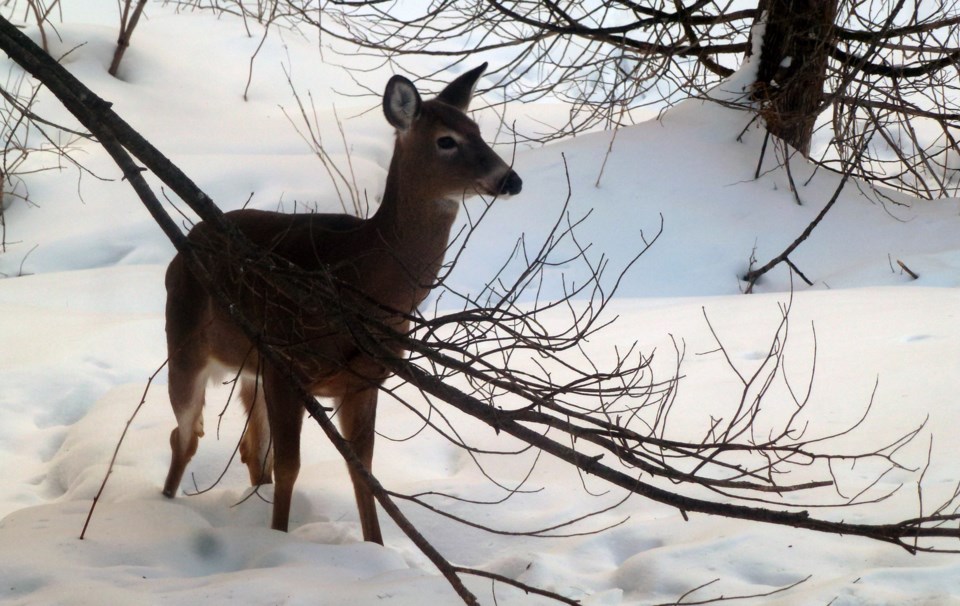The recent (and, almost only, so far) snowfall provided a great opportunity to see what animals are slinking about the farm under cover of moonlight.
Interestingly, no raccoon or skunk tracks have been found yet that were quite prevalent last year. Lots of turkey, grey squirrel, red squirrel, meadow vole and white-footed mice as per usual, although not all are night creatures. But deer tracks — wow — there looks like an invasion of these big mammals is taking place. At least six animals in our orchard, and numerous trails up, down and across the tree plantation areas.
Last week’s column was about a dead deer we found on our property, which indicates life isn’t always kind to wild critters. This week, I am going to look at the wider perspective of the winter living challenges faced by white-tailed deer.
In the really big picture, our deer are just one of at least 38 subspecies of good ol’ Odocoileus virginianus that are spread across North, Central and South America. Our deer are of the subspecies borealis, deer of the north, and occupy the Great Lakes Basin area.
These northern deer have a unique challenge that many of the other subspecies do not have to deal with: winter.
First adaptation is the growing of a pelage of winter fur. The hairs are longer, coarser and hollower than the summer coat. Viewed from a distance, the colour of the deer shifts from reddish brown to bluish grey. This new density and colour are quite advantageous for winter survival, as hollow hair insulates and the winter tree shadows are of the same hue.
When it gets really cold out there, deer can make their hair stand up, thus capturing and saving body heat. When a deer lies down to sleep, the snow under its body will melt due to the hairs being compressed, while the upper body can have a covering of snowfall that does not melt due to the uprightly held fur.
Being vegetarians, finding food in the winter becomes a daily struggle. Even with a four-part stomach and the ability to regurgitate and chew their cud, each animal needs the equivalent of a basketball-sized serving of tree buds. Every animal, every day, all winter long. It does not take long to strip an area clean of easily accessed food.
Unlike raccoons and bears, deer do not have the ability to create an ‘extra fat layer’ that can be used when the going gets tough. They must eat almost constantly to replace the energy used in finding more food to eat. Vicious cycle.
There once was a winter activity engaged by hunters and conservation groups to supply winter food for deer, usually hay bales. This killed a lot of deer, as their digestive enzymes change in the winter and hay cannot be digested. Deer died of starvation while their stomachs were stuffed full of hay.
Nowadays, a mix of whole corn and nuts may be offered as supplemental food, but that practice is fraught with peril as well. More on that in another column perhaps.
Compounding this food-finding task is that deer usually gather in large herds during the winter, sometimes numbering into hundreds of animals. These gatherings are called deer yards and, like a school yard, the snow becomes trampled flat and movement around the woodlot is somewhat easier.
This yarding trait is both beneficial and detrimental to deer survival. Yes, the packed trails allow the animals to reach more trees (usually white cedar, hemlock and maple), but the sheer number of animals travelling together creates a competition that often means “No soup for you.”
While the packed trails allow for better deer travel, they also allow for expedited dog and coyote travel. These canines, both domestic and wild, have padded feet with toes that spread out, allowing them to traverse deeper snow, whereas the deer, with their sharp hooves, quickly sink into the deep, fluffy stuff should they leave the safety of the trail.
Several studies have proven off-leash and free-roaming dogs kill significantly more deer than any family of coyotes. Domestic dogs are fed daily and have great physical endurance, whereas a half-starved coyote chasing a half-starved deer is a bit more of a natural balance.
Deer yards are used annually, the same wooded valley known to generations of deer as a place of refuge. Often heavily treed with white cedar and hemlock, these sites also contain numerous red maple saplings. When the sapling gets munched upon, the next year, it sends up numerous sucker stems, providing more food availability for next winter.
Deer biologists who survey deer yards may use a series of transect lines to criss-cross a yard, counting both browsed stems and pellet groups. (a.k.a. deer poop). Yearly comparisons of these counts reveal habitat suitability and deer population status.
If you find a browsed shrub, it is possible to determine whether it was a deer or a rabbit that nipped off the leader growth. Deer do not have upper front teeth, just a set of four small teeth on the front of the jaw; they rip the twig by clamping it against a tough pad on the roof of their mouth and tugging and sawing with the lower teeth.
By comparison, rabbits and hares have both upper and lower front teeth that nip off the stem like a pair of scissors. If the stub looks clean cut, you have a rabbit nearby; if the stem is half-cut and ragged, a deer has passed by.
Much has been researched, written and shared about deer biology and management, with much of the information often focusing on the survival capabilities of these awesome animals.
Hopefully, you will encounter some tracks in the snow and (with dog firmly leashed) will be able to understand a bit more about the unique abilities of this species to survive winter.
